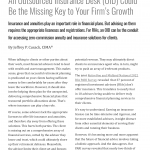What are advisors really worried about?
A recent ThinkAdvisor piece about the LIFE Act was framed as a debate between Robert Bloink (pro) and William H. Byrnes (con), both professors and co-authors of reference book Tax Facts.
For those unfamiliar, the core issue that advisors seem to be anxious about is the LIFE Act’s allowance for annuities within employer-sponsored 401(k) plans to be made the default option for participants. Proponents tend to argue that annuities provide a good source of lifetime income and, for those who leave their 401(k) plans in the default allocations, this might provide better retirement security than a default portfolio allocation would.
Opponents (an overwhelming 75%, according to our 2022 Protected Accumulation + Retirement Income study) argue that defaulting clients into annuities prevents advisors from offering holistic advice on their retirement preparedness, and that a lack of liquidity in annuities can trap clients into solutions that aren’t the best fit for them.
Both arguments have merit, and it’s a debate worth having. However, toward the end of the piece, Bloink disarms the entirety of the opposing argument with this quote:
Plan participants who allow their investments to be put into a default investment option may not even have financial advisors. Not every taxpayer has the resources or desire to work with a professional financial advisor. It’s those very participants who will benefit the most from the default annuity option.
This is a good point, and one that Byrnes doesn’t have a counter-argument for. After all, the Northwestern Mutual 2022 Planning & Progress Study found that only 35% of Americans report working with a financial advisor. Even if the entirety of the other 65% are allowing their retirement plans to default into annuities (setting aside the fact that, statistically speaking, many of them don’t even have employer-sponsored plans), they still aren’t any financial advisor’s client, so they aren’t getting holistic advice anyway.
Presumably, those who do use a financial advisor would be advised of their options and make a proactive choice rather than let their plans remain in the default option, if the advisors in question are living up to fiduciary standards.
Annuities are Nothing to be Afraid Of
Even supposing the LIFE Act’s detractors are right, and that their clients will allow their retirement savings to default into annuities en masse, why is that a problem? The money isn’t likely to go into an annuity right away, because most default annuity plans are likely to put a percentage of the client’s retirement savings into an annuity around age 55 or later. Plenty of time to talk to clients about their options.
Even if a client winds up with an annuity they don’t want, or that the advisor doesn’t want them to have, there are solutions for that, too. RetireOne, for example, helps advisors transfer annuities held-away elsewhere to low-cost, fee-based annuity solutions on our own platform, allowing the advisor to manage the asset as an interested third party. That means advisors can still advise on these assets and ensure that their clients have the solution that works best for their situation and goals. They don’t have to worry about regulatory headaches or compliance because we handle all that, and they don’t even have to pay for the service.
It’s also getting harder to make the argument that annuities aren’t a necessary part of a retirement plan. Maybe the specific annuity a client is defaulted into is sub-optimal, but the solution for many is likely still an annuity. The University of Arizona recently published a paper examining the efficacy of the 4% rule. There’s been a lot of talk about how it’s no longer a viable decumulation strategy, but the paper makes the case that the 4% rule may not have even been realistic when it was created.
Researchers also had some sobering findings about how useful a systematic withdrawal strategy actually is:
To achieve a 1% ruin probability, for example, retirees must adopt a withdrawal rate of just 0.80%, or just $8,000 of withdrawals per year for $1 million in savings. When they attempt to balance the desires to achieve a higher standard of living and to avoid financial ruin, the researchers find that a retired couple willing to bear a 5% ruin probability may withdraw 2.26% per year.
Given that, it’s hard to imagine a scenario where an advisor can, in good conscience, recommend against using some form of guaranteed lifetime income in retirement.
At the end of the day, we want people to be able to enjoy their retirement, or at least survive. That’s what the LIFE Act is aiming for. Is it a perfect solution? Probably not. But it’s very likely a better solution than the alternative for many Americans.



